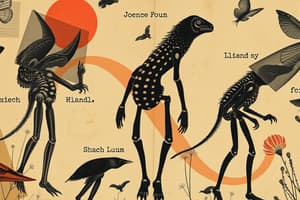Podcast
Questions and Answers
What is the largest classification group used for classifying all organisms?
What is the largest classification group used for classifying all organisms?
- Phylum
- Class
- Species
- Kingdom (correct)
What is the name of the kingdom of many-celled organisms that move about and eat food?
What is the name of the kingdom of many-celled organisms that move about and eat food?
Animal
What is a class?
What is a class?
A phylum is divided into this level of classification.
What is family in terms of biological classification?
What is family in terms of biological classification?
What is the kingdom name of many-celled organisms that contain chlorophyll?
What is the kingdom name of many-celled organisms that contain chlorophyll?
What is genus?
What is genus?
What are fungi?
What are fungi?
What is the classification of organisms known as single-celled that reproduce by cell division?
What is the classification of organisms known as single-celled that reproduce by cell division?
What is phylum?
What is phylum?
What kingdom includes mostly single-celled organisms with nuclei and organelles?
What kingdom includes mostly single-celled organisms with nuclei and organelles?
What defines a species in biological classification?
What defines a species in biological classification?
What is taxonomy?
What is taxonomy?
What level of classification is an order?
What level of classification is an order?
The seven levels of classification are: Kingdom, Phylum, Class, Order, Family, Genus, ______.
The seven levels of classification are: Kingdom, Phylum, Class, Order, Family, Genus, ______.
Flashcards are hidden until you start studying
Study Notes
Classification Overview
- Kingdom is the largest classification group encompassing all organisms.
- The classification hierarchy includes seven levels: Kingdom, Phylum, Class, Order, Family, Genus, and Species.
Kingdoms
- Animal Kingdom comprises multicellular organisms that move and consume food; includes humans.
- Plant Kingdom consists of multicellular organisms containing chlorophyll, primarily stationary.
- Fungi Kingdom represents multicellular organisms that absorb nutrients from other organisms.
- Bacteria Kingdom involves single-celled organisms reproducing through cell division.
- Protista Kingdom includes mostly single-celled organisms with nuclei and organelles, some having cell walls; e.g., amoebas.
Classification Levels
- A class is a subdivision of a phylum; mammals exemplify this level.
- Family is a division of an order; Ursidae (bears) is a typical family.
- Phylum represents the largest division of the Animal Kingdom.
- Order is subdivided from a class; Carnivora is an order of carnivorous mammals.
- Genus is the division within a family; it forms the first part of a scientific name.
- Species, the most specific classification level, distinguishes individual organisms within a genus.
Taxonomy
- Taxonomy is the science dedicated to the classification of living things, organizing biological diversity.
Studying That Suits You
Use AI to generate personalized quizzes and flashcards to suit your learning preferences.




